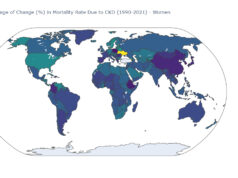 A study in Urologic Oncology led by Mario Ochoa-Arvizo (University of Edinburgh, Edinburgh, UK) has found that partial nephrectomy is less likely to result in new-onset postoperative chronic kidney disease (CKD) than radical nephrectomy. The systematic literature review and meta-analysis did not, however, find that it provided significant additional protection against advanced CKD or end-stage renal disease (ESRD).
A study in Urologic Oncology led by Mario Ochoa-Arvizo (University of Edinburgh, Edinburgh, UK) has found that partial nephrectomy is less likely to result in new-onset postoperative chronic kidney disease (CKD) than radical nephrectomy. The systematic literature review and meta-analysis did not, however, find that it provided significant additional protection against advanced CKD or end-stage renal disease (ESRD).
Ochoa-Arvizo et al recount how radical nephrectomy has traditionally been the “gold standard treatment for kidney cancer and the most common approach for small renal masses,” which account for around 3% of cancers. Partial nephrectomy, meanwhile, is now the option used for 60% of nephrectomies as radical nephrectomy has been associated with an increased risk of CKD.
They draw particular attention to the European Organization for the Research and Treatment of Cancer (EORTC) randomised trial from 2014, though not without suggesting that its conclusions, which included a “higher rate of cardiovascular mortality” with partial nephrectomy, may have been compromised by “methodological bias and significant loss of follow-up”. Others such as the meta-analysis by Zheng Wang (Shandong University, Jinan, China) et al have indicated a lower postoperative CKD onset risk but showed little in the way of cardiovascular protection.
With all of this in mind, Ochoa-Arvizo et al designed their own literature review and meta-analysis to clarify further the advantages or otherwise of partial nephrectomy and to “reconcile the conflicting results”. The authors included studies that compared renal function and adverse cardiovascular events in patients with renal cell carcinoma (RCC) who had a partial or radical nephrectomy with at least three months of follow-up and reported an adjusted effect estimate (hazard ratio or odds ratio). Metastatic renal disease, bilateral kidney tumours, and a solitary kidney were all patient characteristics singled out for exclusion.
For their qualitative analysis, 64 eligible studies were identified. The quantitative analysis, meanwhile, included 31 studies with functional renal outcome data, accounting for 20,713 patients who received partial nephrectomy and 31,153 who received radical nephrectomy, for 51,866 in total. The meta-analysis of these studies found a three-fold and four-fold increased risk of new-onset CKD with estimated glomerular filtration rate (eGFR) <60mL/min/1.73m2 and <45mL/min/1.73m2, respectively.
There was a 19% reduction in cardiovascular events with partial nephrectomy, though not a statistically significant reduction for cardiovascular mortality. The authors stipulate that “these outcomes should be viewed against the reporting of mostly retrospective studies, and significant heterogeneity across them”.
Stating that their results “are consistent with those of Wang et al to some extent,” Ochoa-Arvizo et al also mark 78% and 77% risk reductions for T1a and T1b tumours respectively. They also say the results “parallel” those of the EORTC trial in that they found no significantly changed risk of ESRD after radical nephrectomy, even though it is associated with higher risk of CKD. The study authors emphasise that “the decision of partial versus radical nephrectomy should be individualised”, as the former “did not show a protective effect of postoperative eGFR <30mL/min/1.73m2 and has no clear role in decreasing the risk of important cardiovascular events”.
The study is “not devoid of limitations”, the authors note. The results were based largely on observational studies, they say, and the risk of selection bias in treatment allocation should be considered. Also important to include in such considerations is the “high statistical heterogeneity” in the analysis, with a “limited” ability to adjust for confounding factors such as surgical technique and ischaemia parameters. Ochoa-Arvizo et al’s conclusion posits finally that partial nephrectomy “lowers the risk” of new-onset CKD. It fails, however, to demonstrate the same “independent protective effect” on individual cardiovascular events as it does on composite ones.












